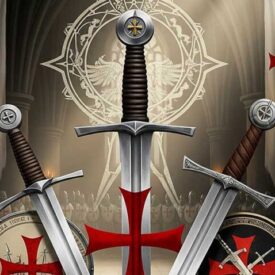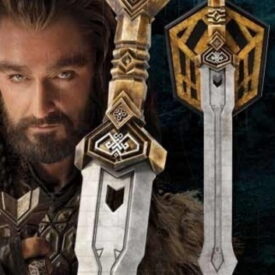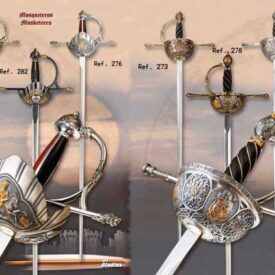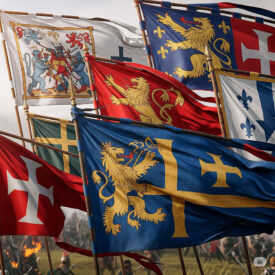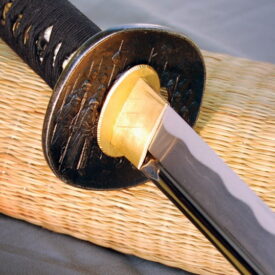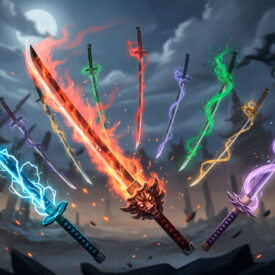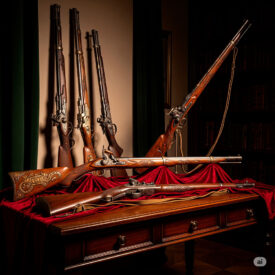Imagine a battlefield where the clang of weapons echoes and life hangs by a thread. In that crucible of steel and valor, the protection of the warrior’s hand was as crucial as the sharpness of his blade.
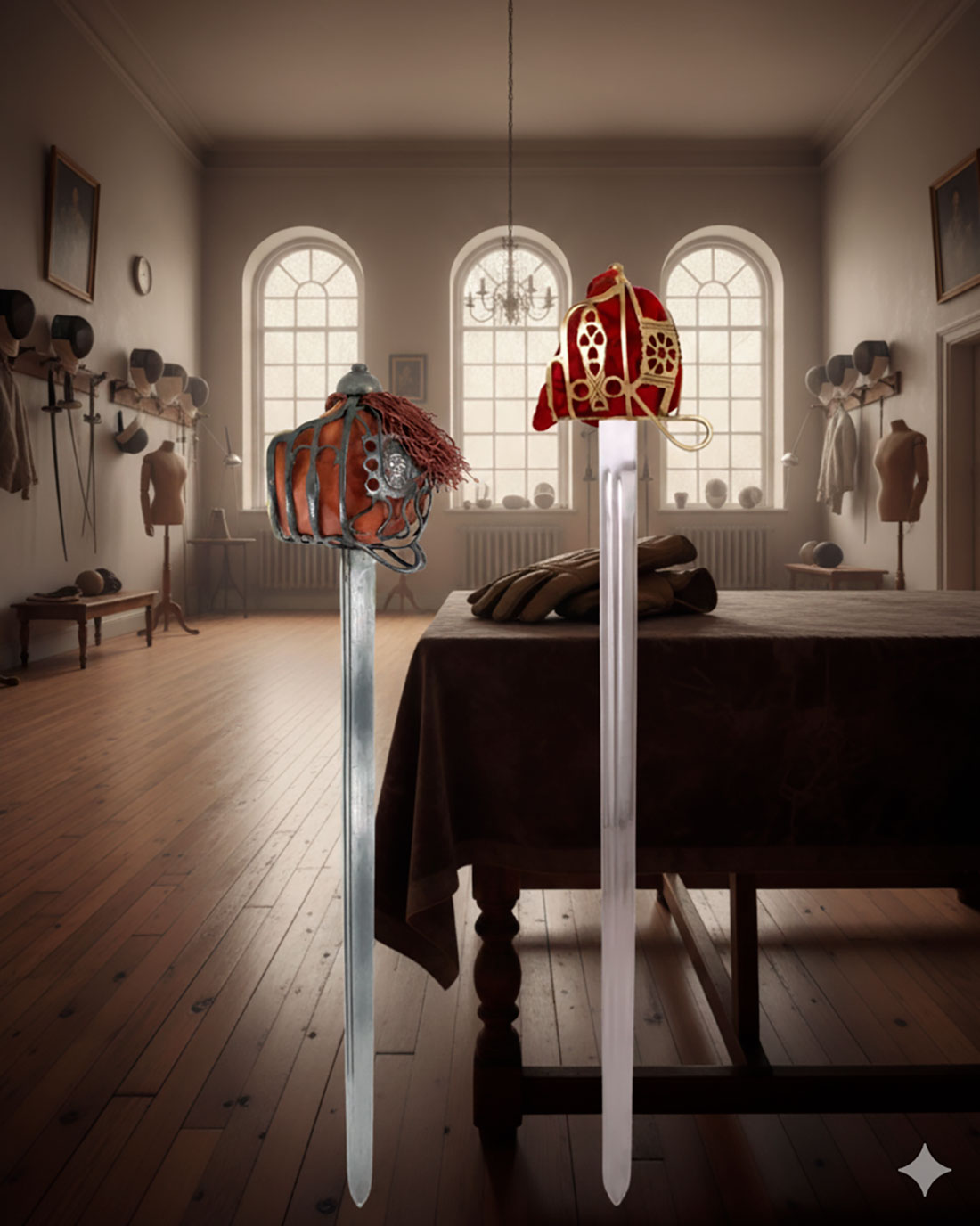
English basket-hilted swords, with their distinctive railed guard, not only offered vital defense but also forged their own legend in the tumultuous history of Great Britain. Get ready to discover how these majestic weapons evolved from functional tools of war to symbols of status and skill.
The Birth of a Legend: Origin and Evolution of the Basket Hilt
The basket-hilted sword represents a milestone in the design of modern bladed weapons, characterized by an elaborate hilt that protects the swordsman’s hand. This ingenious development arose from the evolution of quillons added to the crossguards of swords from the Late Middle Ages, elevating protection to an unprecedented level.
The “Broadsword”: A Versatile Concept
These swords are often called the “broadsword”, a term which, though ambiguous, came to define the double-edged European basket-hilted swords used by cavalry from the 17th century onwards. It was used to distinguish them from the slender rapier and the small-sword, thrust-oriented weapons preferred in civilian duels.
A true broadsword boasts a double-edged blade, while its single-edged “cousins” are known as sabers or backswords. The adaptability of the basket hilt allowed it to be mounted on both broad and single-edged blades, demonstrating the versatility of its protective design. Nineteenth-century historians often applied this term to any sword with a wider blade than contemporary dueling swords, albeit with some imprecision.
The Chronology of Steel and Protection
The basket hilt did not appear overnight, but was the result of centuries of innovation and adaptation on European battlefields. Below, we present a chronology detailing its fascinating evolution, from its origins to its prolonged use in infantry and cavalry.
| Era | Event |
|---|---|
| Origins and development (15th–16th Centuries) | |
| c. 1450 | Early examples of Hungarian swords show the “cat’s-head pommel”, an element later associated with the Schiavona. |
| Second half of the 15th century | The beginnings of the shift from medieval cruciform swords to more complex hilts begin to appear. |
| Late 15th century | The first forms of the two-handed Claymore appear, evolving from hand-and-a-half and two-handed swords in Europe. |
| Early 16th century | The basket-hilted sword emerges on European and British Isles battlefields, in response to the need for hand protection. |
| c. 1520 | The first progenitors of basket hilts in the British Isles are located: early asymmetrical designs. |
| Mid-16th century | The basket-hilted sword type is consolidated; the technical development of the basket continues during this period. |
| 1545 | One of the first basket-hilted swords is recovered from the wreck of the Mary Rose, sunk in 1545. |
| c. 1550 | Examples of asymmetrical English/Scottish basket hilts that gave rise to many subsequent generations of basket guards in the British Isles. |
| Second half of the 16th century | A shift towards symmetrical designs in simple British basket hilts is observed, a style that would last until c.1680; in Italy, the popularity of the Venetian Schiavona begins. |
| c. 1560–1580 | Known example of a Swiss saber with an early asymmetrical basket guard. |
| c. 1580–1590 | Very early Schiavona appear, built with fewer bars and with the classic ovoid shape of later models. |
| c. 1580–1617 | Thousands of Tessaks (German/Styrian basket forms) are imported from Germany and distributed among Norwegian peasant militias. |
| Late 16th / early 17th century | The single-handed variant of the Claymore is introduced in Scotland, known as the Lowland Claymore or “basket-hilted sword”. |
| Consolidation and regional variants (17th Century) | |
| 17th century | The basket hilt gains widespread popularity; the term “broadsword” is used to distinguish these pieces from smallswords. |
| c. 1600 / 1611 | An early example of Schiavona bears the mark of the Doge’s palace and the Scottish shield of Fergusson of Glenshellish; an associated dated record is 1611, which shows Italo-Scottish connections. |
| 1612 | The “Sinclair hilt” is named after George Sinclair, a Scottish mercenary killed at the Battle of Kringen (Norway). |
| After 1625 | The so-called “mortuary sword” (a type decorated with faces or masks) is used in cavalry during the English Civil War. |
| 1642–1670 (approx.) | Mortuary hilts and variants associated with the English Civil War remain in use in the conflict and in the post-war period. |
| 1649 | After the execution of Charles I, swords with the king’s mask or face (“mortuary” swords) are manufactured as an object of commemoration or propaganda. |
| c. 1650 | Examples of mid-17th century Schiavona feature a simple “ladder” guard in their basket. |
| c. 1670 | The widespread use of mortuary swords continues until approximately this date. |
| 1672 | After campaigns in the Netherlands, France begins to produce the Walloon sword as its first regulation weapon of this type. |
| Late 17th century | The Scottish broadsword with a basket hilt is common among clans and combatants during the Jacobite rebellions. |
| Widespread use, adaptation and decline (18th–20th Centuries) | |
| 18th century | The basket hilt remains in widespread use, especially in heavy cavalry until the Napoleonic era; fencing manuals teaching the handling of the Scottish broadsword are published. |
| 1728 | Donald McBane, Scottish fencing master, appears portrayed with a broadsword in his work The Expert Swordsman’s Companion. |
| c. 1750 | The Schiavona reaches a design pinnacle with the triple-ladder guard; high-quality Scottish swords are produced (e.g., examples attributed to Walter Allan of Stirling). |
| 1761 | Samuel Harvey Sr. (Birmingham) manufactures a British Dragoon Sword with a basket hilt. |
| 1797 | The Schiavona disappears with the end of the Republic of Venice, although its forms survive in other traditions. |
| Napoleonic era (late 18th–early 19th century) | Descendants of the basket-hilted sword (with baskets reduced to half or three-quarters) continue in use in cavalry; example: Cavalry Sword Pattern 1796. |
| 1828 | The Pattern 1828 basket-hilted sword is introduced for Highlander regiments in the Victorian era. |
| Until c. 1850 | Weapons with a Walloon design continue to be supplied to the Swedish army from the time of Gustavus Adolphus until the mid-19th century. |
| Late 19th century | Victorian antiquarians popularize the term “Sinclair hilt” to refer to certain Scandinavian swords; collector interest in historical variants increases. |
| Eve of World War I | Pattern 1908 and 1912 cavalry sabers and swords, descendants of the basket-hilted tradition, are still used. |
| World War II | One of the last active uses of the Scottish broadsword in combat was carried out by Major Jack Churchill, known for fighting with a sword and bow in late actions of the conflict. |
Morphology and Construction: Art and Defense in Every Component
The basket-hilted sword was a formidable combat tool, designed for cutting and thrusting. Its primary purpose was to provide maximum protection to the combatant’s hand, an objective achieved with a combination of ingenuity and artisanal mastery.
The baskets incorporated complex systems, from rounded and flattened bars to perforated plates and shell guards. The craftsman’s skill was crucial, as the added weight had to be light for prolonged handling in the heat of battle. At the same time, the guard had to be effective in repelling enemy blows without impeding the agility of the hand and wrist.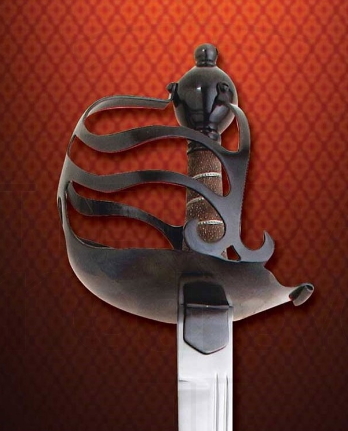
Initially, the hilts could encapsulate the hand symmetrically or asymmetrically. It is believed that the earliest basket hilts in the British Isles were asymmetrical, prioritizing external hand coverage. However, over time, they evolved into more symmetrical designs, offering more balanced protection.
English Basket-Hilted Swords: A Martial Heritage
In England, basket-hilted swords acquired particular relevance, especially in the hands of the cavalry. The Mortuary Sword, for example, was a type of cutting and thrusting sword used by cavalry during the English Civil War.
This emblematic example, generally with a double-edged blade and a half-basket hilt, became tragically famous for its name, which arose in the 18th century from pieces depicting the face or death mask of King Charles I after his execution in 1649. It was even the preferred weapon of historical figures such as Oliver Cromwell, the General of the English Parliamentary Forces.
Today, the original of this type of sword, such as the one associated with Cromwell, is found in the prestigious Royal Armouries at the Tower of London, the UK’s National Museum of Arms and Armour. The exquisite decoration of the basket on these swords reflects surprising beauty and unparalleled artisanal mastery.
The Legacy of the Basket-Hilted Sword in Cavalry
The influence of basket-hilted swords extended far beyond the English Civil War. Their descendants, often with baskets reduced to “half” or “three-quarters,” remained in use in cavalry during the Napoleonic era and throughout the 19th century. Models such as the Heavy Cavalry Saber Model 1796 and British officer swords up to World War I are testament to their durable design.
Regional Variants: Between England and Scotland
The development of the basket hilt occurred simultaneously in multiple regions, each leaving its distinctive mark. While English basket-hilted swords, like the mortuary sword, prioritized military functionality and their adoption in cavalry, their Scottish cousins, like the Lowland Claymore, often incorporated rich ornamentation with Celtic motifs, becoming symbols of identity and resistance for the clans.
English hilts tended to be more sober in design, focusing on effectiveness, while Scottish ones were distinguished by more complex and elaborate forms. Both styles reflect the needs and cultural spirit of each nation but share the essential function of protecting the warrior’s hand in the heat of battle.
Materials Forged for Battle: The Essence of Basket-Hilted Swords
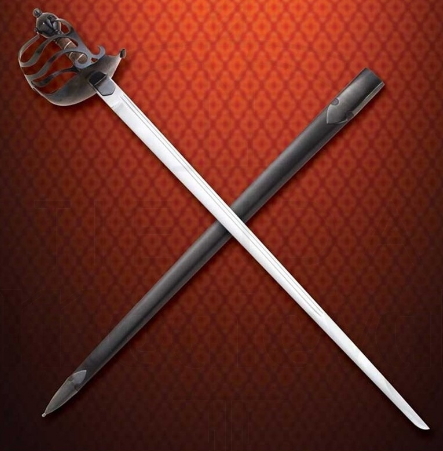 17th-century basket-hilted swords were primarily made from high-quality carbon steel. This material was forged and tempered with mastery to achieve an optimal combination of hardness, strength, and elasticity in the blade.
17th-century basket-hilted swords were primarily made from high-quality carbon steel. This material was forged and tempered with mastery to achieve an optimal combination of hardness, strength, and elasticity in the blade.
The hilt, especially the protective basket, was also made of steel, skillfully shaped to absorb impacts and ensure safe handling. Traditional forging, tempering, and annealing techniques were essential to create durable and reliable weapons capable of withstanding the rigorous demands of combat.
Resolve your doubts about basket-hilted swords
What are the main differences between English and Scottish basket-hilted swords?
Main differences between English and Scottish basket-hilted swords
Most of the differences between these swords lie in the design of the hilt and the cultural destiny of the weapon.
Basket hilt
- Both nationalities developed basket hilts in the late Renaissance and early modern period to protect the combatant’s hand, but the Scottish basket is especially recognized for its distinctive shape and ornamentation.
- Scottish hilts often have more complex forms and frequently incorporate engravings or decorations with Celtic motifs (e.g., animal figures), which gives them a more unique visual character.
- English hilts, although functionally similar, tend to be simpler in their decoration and design variants.
Purpose and use
- In Scotland, the basket-hilted sword (as it evolved from the Claymore) became associated with national identity and the status of the clans, being a symbol of independence and resistance.
- In England, these swords were rather a technical response to the needs of combat with light swords and did not achieve the same national symbolic status.
Evolution and cultural weight
- The Scottish basket-hilted sword is a direct evolution of the Claymore tradition, but adapted for one-handed use and for lighter, faster fencing.
- In England, development was more influenced by continental fencing and adaptation to new military tactics and civilian duels, but without the marked identity burden that characterizes Scottish ones.
Visual summary
| Characteristic | Scottish basket-hilted sword | English basket-hilted sword |
|---|---|---|
| Basket design | More elaborate, often decorated | Simpler, less ornamented |
| Cultural significance | National, clan, and resistance symbol | Functional weapon, less symbolic |
| Evolution | From Claymore tradition to one-handed | Continental influences, duel |
| Ornamentation | Celtic motifs, beasts, engravings | More sober style |
- Scottish basket-hilted sword
-
- Basket design: More elaborate, often decorated
- Cultural significance: National, clan, and resistance symbol
- Evolution: From Claymore tradition to one-handed
- Ornamentation: Celtic motifs, beasts, engravings
- English basket-hilted sword
-
- Basket design: Simpler, less ornamented
- Cultural significance: Functional weapon, less symbolic
- Evolution: Continental influences, duel
- Ornamentation: More sober style
In short, although both share the protective function of the basket, the Scottish one stands out for its artistic elaboration and symbolic weight, while the English one prioritizes functionality and adaptation to changing combat styles.
What combat techniques were most effective with basket-hilted swords?
The most effective combat techniques with basket-hilted swords are based on leveraging their unique design, which includes a basket or guard that protects the swordsman’s hand. Below are some of the most prominent techniques:
- Use of the basket: The additional protection provided by the basket allows for more aggressive maneuvers, as the swordsman can keep his hand in a safer position.
- Close combat: Due to their design, basket-hilted swords are ideal for fighting in confined spaces or in situations where the opponent is close. This allows for thrusting and short cutting techniques to be used.
- Defense and counterattack: The basket facilitates defense against short attacks, allowing the swordsman to receive blows without suffering serious injury. Then, they can counterattack quickly and accurately.
- Fast and direct movements: Basket-hilted swords are often heavier in the basket than in the blade, making them ideal for fast and direct movements, such as thrusts and short cuts.
- Space control: The basket allows the combatant to better control space during combat, which is crucial in close-combat situations.
How did basket-hilted swords influence the English Civil War?
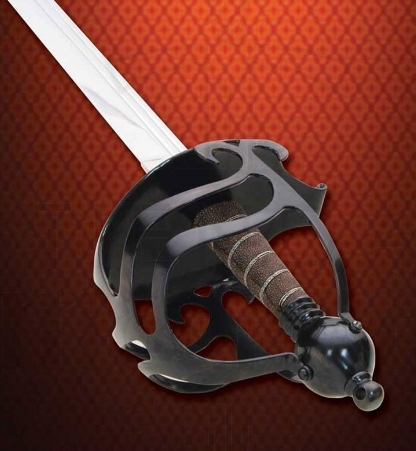 Basket-hilted swords, such as the mortuary sword and other variants, had a notable presence in the English Civil War (1642–1651) primarily as secondary armament for officers and cavalry soldiers. Their design—a straight, double-edged blade of medium length and a protective metal hilt—offered an effective combination of cutting and thrusting capability, along with superior hand protection against enemy blows and cuts.
Basket-hilted swords, such as the mortuary sword and other variants, had a notable presence in the English Civil War (1642–1651) primarily as secondary armament for officers and cavalry soldiers. Their design—a straight, double-edged blade of medium length and a protective metal hilt—offered an effective combination of cutting and thrusting capability, along with superior hand protection against enemy blows and cuts.
These swords were not the primary weapons of the armies (where muskets, pikes, and cuirasses predominated), but their evolution during this period reflects the growing importance of personal protection in close combat, both on foot and on horseback. The use of the basket-hilted sword in the English Civil War helped consolidate its functional design, which would later be adapted and generalized in European cavalry during subsequent centuries. Thus, its influence was more technical and evolutionary than decisive in the military outcome of the conflict, contributing to the professionalization and specialization of individual armament in modern armies.
What materials were used to make basket-hilted swords in the 17th century?
17th-century basket-hilted swords were primarily made from high-quality carbon steel that was forged and tempered to achieve a suitable combination of hardness, strength, and elasticity in the blade. Additionally, the hilt, especially the basket that protects the hand, was generally also made of steel, shaped to absorb impacts and allow for safe handling. Some blades featured fullers to lighten weight and reinforce strength. Traditional techniques included forging to conform the shape, tempering for hardness, and annealing to prevent brittleness.
What distinctive characteristics do basket-hilted swords from the 16th and 17th centuries have?
Basket-hilted swords from the 16th and 17th centuries present several distinctive characteristics:
- Hilt design: Their hilt is designed in the shape of a basket, which provides excellent protection for the swordsman’s hand, minimizing the risk of injuries during combat.
- High-quality materials: They are made of high-quality metal, which guarantees their durability and functionality.
- Weapon balance: The design allows for optimal balance, facilitating agile and rapid movements during the fight, making them ideal for fencing practice.
- Versatility in combat: They allow for a wide variety of attack and defense techniques, which made them a popular choice for both soldiers and wealthy civilians.
- Cultural influences: Their design reflects cultural exchanges, influenced by similar weapons in the continental European army.
English basket-hilted swords represent a fascinating chapter in the history of bladed weapons. From their protective functionality to their aesthetic evolution and their role in conflicts that shaped nations, these swords are much more than simple objects of steel: they are a testament to human ingenuity and the constant pursuit of superiority on the battlefield. Their legacy endures, inviting us to explore the rich tapestry of history and the art of fencing.
